<< Previous | Displaying results 2801-2850 of 6769 for "" | Next >>
Soviet soldiers in a street in the Soviet occupation zone of Berlin following the defeat of Germany. Berlin, Germany, after May 9, 1945.
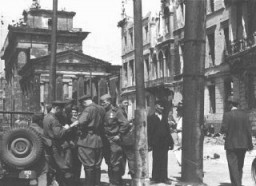
Soviet soldiers in the Soviet occupation zone of Berlin following the defeat of Nazi Germany. Berlin, Germany, after May 9, 1945.
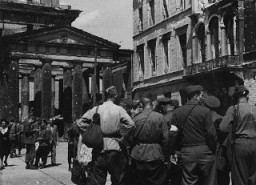
An African American soldier is among those members of the Soviet and US armed forces posing here upon the historic meeting of the two armies on the Elbe River. Torgau, Germany, April 26, 1945.
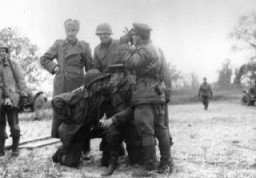
Tsila Botvinnik, a Jewish partisan active in the Minsk ghetto underground against the Germans. Minsk, Soviet Union, between 1941 and 1944.
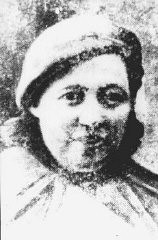
Mikhael Guebelev, organizer of the underground group in the Minsk ghetto. Soviet Union, date unknown.
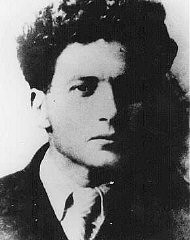
German soldiers direct artillery against a pocket of resistance during the Warsaw ghetto uprising. Warsaw, Poland, April 19-May 16, 1943.

German soldiers burn residential buildings to the ground, one by one, during the Warsaw ghetto uprising. Poland, April 19-May 16, 1943.
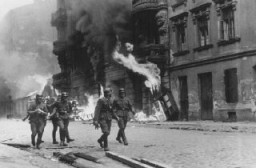
SS personnel capture two Jewish resistance fighters who were pulled from a bunker during the suppression of the Warsaw ghetto uprising. Warsaw, Poland, April 19-May 16, 1943.
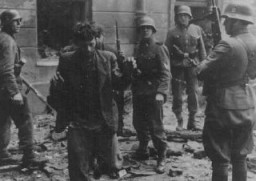
German soldiers arrest Jews during the Warsaw ghetto uprising. Poland, May 1943. The Warsaw ghetto uprising began on April 19, 1943, after German troops and police entered the ghetto to deport its surviving inhabitants. By May 16, 1943, the Germans had crushed the uprising, deported surviving ghetto residents, and left the ghetto area in ruins.
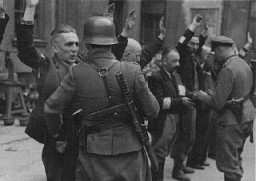
Members of the Jewish resistance are captured by SS troops on Nowolipie Street during the suppression of the Warsaw ghetto uprising. Warsaw, Poland, April 19-May 16, 1943.
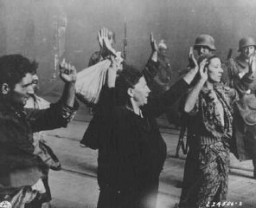
Jews captured by German troops during the Warsaw ghetto uprising in April–May 1943. This photograph appeared in the Stroop Report, an album compiled by SS Major General Juergen Stroop, commander of German forces that suppressed the Warsaw ghetto uprising. The album was introduced as evidence at the International Military Tribunal at Nuremberg. In the decades since the trial this photo has become one of the iconographic images of the Holocaust.
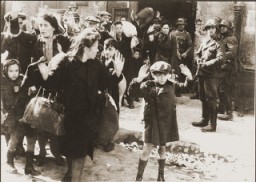
German soldiers lead Jews captured during the Warsaw ghetto uprising to the assembly point for deportation. Poland, May 1943.
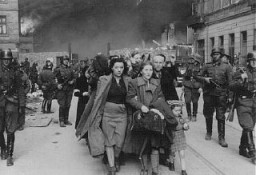
Jews captured by the SS during the Warsaw ghetto uprising are interrogated beside the ghetto wall before being sent to the Umschlagplatz, the assembly point for deportation from the ghetto. The original German caption reads: "Search and Interrogation." Poland, May 1943.
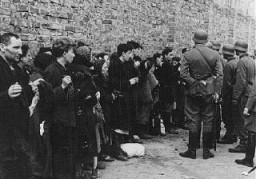
Jews captured during the Warsaw ghetto uprising. Poland, April 19–May 16, 1943.

Deportation of Jews from the Warsaw ghetto during the ghetto uprising. The original German caption reads: "To the Umschlagplatz." Warsaw, Poland, May 1943.
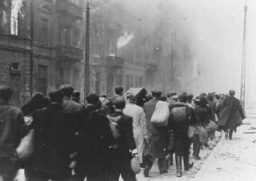
Jews captured during the Warsaw ghetto uprising are marched past the St. Zofia hospital down Nowolipie Street towards the Umschlagplatz for deportation.
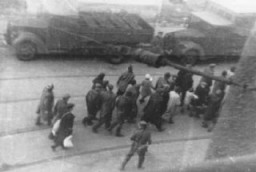
Photograph from SS General Juergen Stroop's report showing the Warsaw ghetto after the German suppression of the ghetto uprising. Stroop, commander of German forces that suppressed the Warsaw ghetto uprising, compiled an album of photographs and other materials. This album later came to known as "The Stroop Report." The right of this image from the album shows a column of Jews being transported out of the ghetto for deportation. Warsaw, Poland, April–May, 1943.
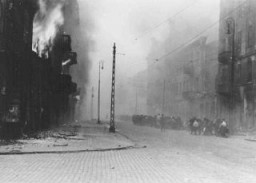
Ruins of the Warsaw ghetto after the Warsaw ghetto uprising. Poland, May 1943.
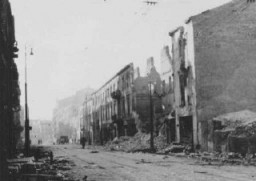
Barracks in the Auschwitz-Birkenau camp. This photograph was taken after the liberation of the camp. Auschwitz-Birkenau, Poland, after January 29, 1945.
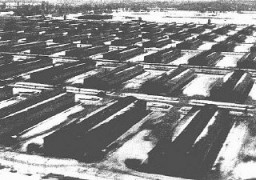
The Black Wall, between Block 10 (left) and Block 11 (right) in the Auschwitz concentration camp, where executions of inmates took place. Poland, date unknown.
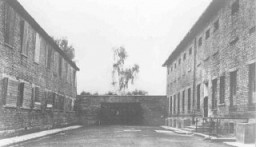
A transport of Jews from Hungary arrives at Auschwitz-Birkenau. Poland, May 1944.
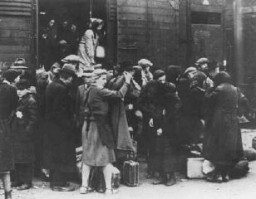
A transport of Hungarian Jews lines up on the ramp for selection at the Auschwitz-Birkenau killing center in German-occupied Poland. May 1944. In mid-May 1944, the Hungarian authorities, in coordination with the German Security Police, began to systematically deport the Hungarian Jews. SS Colonel Adolf Eichmann was chief of the team of "deportation experts" that worked with the Hungarian authorities. The Hungarian police carried out the roundups and forced the Jews onto the deportation trains. In…
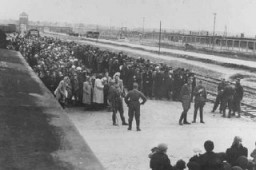
Jewish women and children from Subcarpathian Rus who have been selected for death at Auschwitz-Birkenau, walk toward the gas chambers. May 1944.
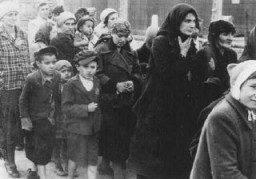
Bombing raid over the I.G. Farben Buna plant. Poland, August 1944.
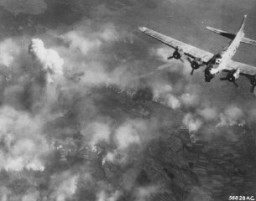
Aerial photograph of Auschwitz II (Birkenau). Poland, December 21, 1944. This image is one of a series of aerial photographs taken by Allied reconnaissance units under the command of the 15th US Army Air Force during missions dating between April 4, 1944, and January 14, 1945.
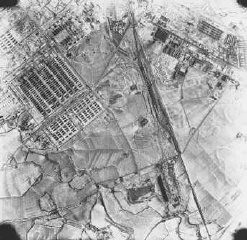
Aerial photograph of the Auschwitz III (Monowitz) camp, which was adjacent to the I.G. Farben plant. The photograph was taken following US bombing missions. Poland, January 14, 1945.
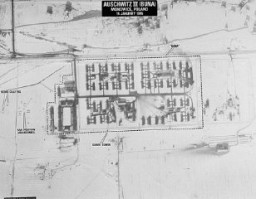
Under SA guard, a group of leading Socialists arrives at the Kislau camp, one of the early concentration camps. Local Social Democratic party leader Ludwig Marum is fourth from the left in the line of arrivals. Kislau, Germany, May 16, 1933.
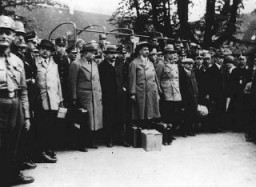
A sign, in both German and Latvian, warning that people attempting to cross the fence or to contact inhabitants of the Riga ghetto will be shot. Riga, Latvia, 1941–43.
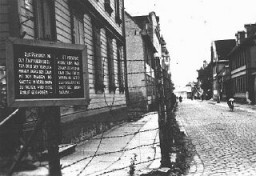
Deportation of Jews from Hanau, near Frankfurt am Main, to the Theresienstadt ghetto. Hanau, Germany, May 30, 1942.

Jews forced into the Kovno ghetto move their belongings into the ghetto. In the center, a man is pulling a disassembled wardrobe. He was never able to put it together because of the crowded conditions in the ghetto. Clothes were often hung from nails in the wall instead. Lithuania, ca. 1941-1942.
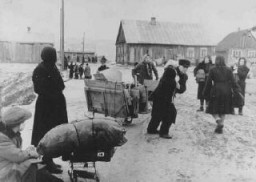
Arrival of a transport of Dutch Jews in the Theresienstadt ghetto. Czechoslovakia, February 1944.
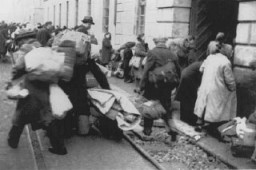
Yakob Vizgordiski works at a machine in a ghetto factory. Kovno, Lithuania, between 1941 and 1943.
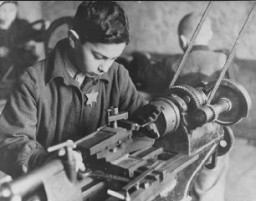
An emaciated child eats in the streets of the Warsaw ghetto. Warsaw, Poland, between 1940 and 1943.
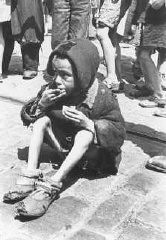
Children eating in a Warsaw ghetto street. Warsaw, Poland, between 1940 and 1943.
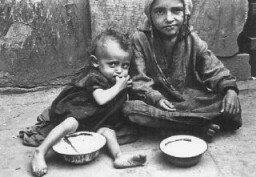
Deportation of Jewish children from the Lodz ghetto in German-occupied Poland during the "Gehsperre" Aktion, September 1942.
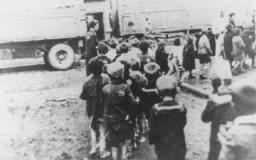
Jewish resistance fighters who were captured by SS troops during the Warsaw ghetto uprising. Warsaw, Poland, April 19-May 16, 1943. The original German caption reads: "These bandits offered armed resistance."
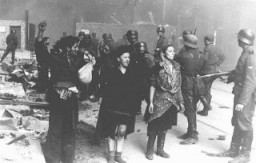
Jews carrying bundles of possessions who were forced to gather at an assembly point before their deportation from the Kovno ghetto, probably to Estonia. Kovno, Lithuania, October 1943. This photograph was taken by George Kadish.
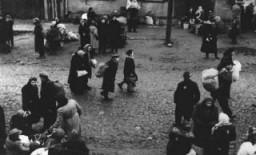
A synagogue used as a warehouse for the belongings of deported Jews. Szeged ghetto, Hungary, 1944.

Ruins of a building in the Kovno ghetto gutted when the Germans attempted to force Jews out of hiding during the final destruction of the ghetto. Photographed by George Kadish. Kovno, Lithuania, August 1944.
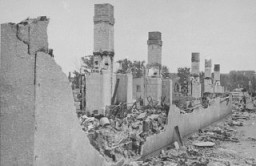
Commercial area on Nalewki Street in Warsaw's Jewish quarter. Warsaw, Poland, 1938.
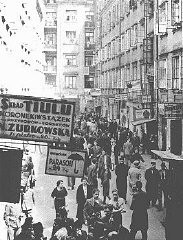
Men, women, and children dig defense ditches during the German siege of Warsaw. Poland, September 1939.

German forces and Polish civilians on the outskirts of Warsaw. In the background of the photograph, the city burns as a result of the German military assault. Warsaw, Poland, September 1939.
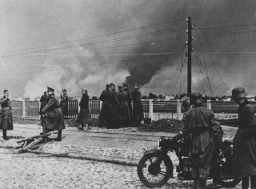
German personnel on Grzybowska Street arrest and search Jewish men who supposedly hid weapons prior to the German occupation of Warsaw. Warsaw, Poland, October-December 1939. This is one of a series of photos taken by Arthur Grimm, an SS propaganda company photographer, documenting the investigative work of the Sicherheitsdienst (SD) in occupied Warsaw for the Berliner Illustrierte Zeitung. Although only some of the photos were published, it is likely that the incidents depicted in the BIZ were staged…
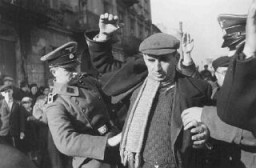
In the Warsaw ghetto, Jewish children with bowls of soup. Warsaw, Poland, ca. 1940. During the Holocaust, the creation of ghettos was a key step in the Nazi process of brutally separating, persecuting, and ultimately destroying Europe's Jews. Ghettos were often enclosed districts that isolated Jews from the non-Jewish population and from other Jewish communities.
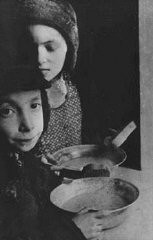
Street scene in the Warsaw ghetto. The sign at left announces: "Soup in the courtyard, first floor, apt. 47." Warsaw, Poland, 1940-1941.
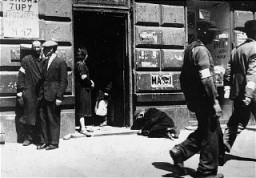
A Warsaw ghetto resident gives money to two children on a Warsaw ghetto street. Warsaw, Poland, between October 1940 and April 1943.
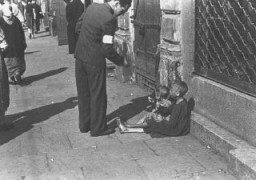
An emaciated woman sells the compulsory Star of David armbands for Jews. In the background are concert posters; almost all are destroyed. Warsaw ghetto, Poland, September 19, 1941. This photograph was taken by Heinrich Joest, a German army sergeant during World War II. On September 19, 1941, he took 140 images of every aspect of life and death in the Warsaw ghetto.
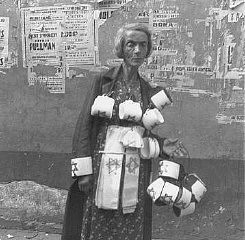
Entrance to the Warsaw ghetto. The sign states: "Epidemic Quarantine Area: Only Through Traffic is Permitted." Warsaw, Poland, February 1941.

Polish civilians walk by a section of the wall that separated the Warsaw ghetto from the rest of the city. Warsaw, Poland, 1940–41.
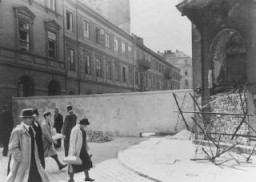
Stall of a street vendor selling old Hebrew books. Warsaw ghetto, Poland, February 1941.
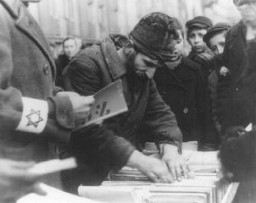
We would like to thank Crown Family Philanthropies, Abe and Ida Cooper Foundation, the Claims Conference, EVZ, and BMF for supporting the ongoing work to create content and resources for the Holocaust Encyclopedia. View the list of donor acknowledgement.